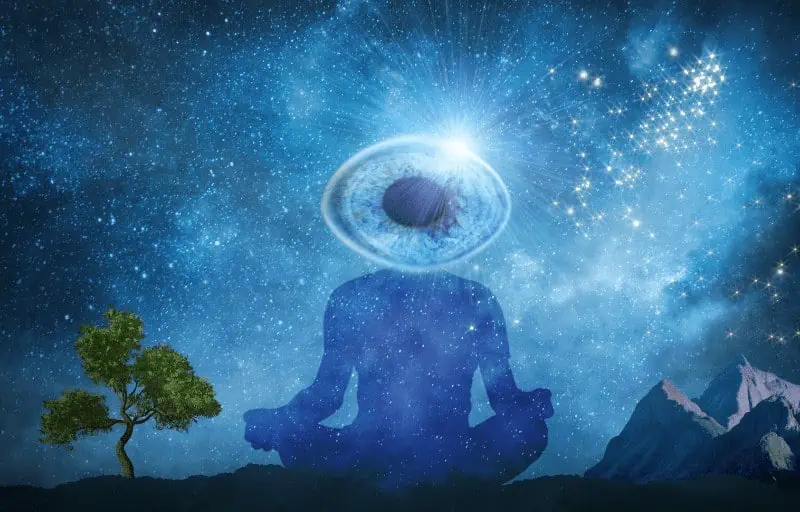How do you define yourself as a person? How do you separate your own identity from other beings in existence? Yoga philosophy’s answer to this age-old question is a concept called ahamkara. As one of the main components that comprise the mind, ahamkara is the vanguard of human consciousness.
This Sanskrit term comes from the root words “aham,” meaning “I” or “self,” and “kara,” which means “doer” or “maker.” Put them together, and ahamkara translates roughly to “I-maker,” describing the part of your psyche that makes you, well, you. For that reason, ahamkara is often equated to the ego in modern psychology. It represents the sense of ‘I’ or self-identity that shapes our perception of reality and its various forms.
Understanding the concept of ahamkara can provide us with insights into our actions and how we engage with the world. It allows us to gain clarity on why we think, feel, and behave in ways. By being conscious of ahamkara, we can navigate through life effectively by making choices that resonate with our selves rather than being swayed by unconscious habits or external pressures.
Becoming familiar with ahamkara is crucial for personal growth and spiritual development. So, let’s journey together into the psyche of yoga philosophy!
Contents
Ahamkara’s Connection to Cosmic Consciousness
Linking Individual and Universal Consciousness
In yoga philosophy, 25 tattva or elements compose the fabric of the universe. Of these tattva, ahamkara plays a pivotal role in connecting individual consciousness with the universal. Ahamkara is fundamentally the sense of self that each person carries.
However, this distinct awareness is not isolated or self-sufficient. It is intricately interconnected with the all-encompassing consciousness that fills every aspect of existence.
Ahamkara’s Relationship to the Psyche
The 25 tattva provide a framework for understanding the nature of reality and consciousness. Each person’s consciousness is divided into four main parts:
- Manas (mind): processes sensory information.
- Chitta (memory): stores experiences that shape our personality.
- Ahamkara (ego): our sense of individual identity.
- Buddhi (wisdom): provides insight to aid in decision-making.
For most of us, our natural state of mind is ahamkara. It forms our unique identity but isolates us from fully understanding our surroundings. It’s like mental armor, protecting us from external threats and limiting our perception.
To tap into buddhi, the decision-making part of the mind, we must overcome ahamkara. Buddhi allows us to see reality without egoist distortions and make decisions based on wisdom, but ahamkara often obstructs its clarity. Therefore, shedding our mental armor is critical to mental and spiritual growth.
Transcending Ahamkara to Experience Oneness
Practicing yoga and meditation helps us develop awareness of ahamkara, enabling us to perceive the relationship between individual and universal consciousness. As self-awareness deepens, we begin to transcend the personal ego and experience a sense of unity and oneness with the universe.
This is not about being transported to a different place but about the process of shifting our perspective and understanding of our place within the cosmos.
Ahamkara is the key that unlocks the door to this profound realization, linking the individual and universal consciousness in a dance of interconnectedness and unity.
Impact on Spiritual Growth
Understanding the connection between cosmic consciousness and ahamkara can profoundly affect spiritual growth.
- First, you understand your true nature and your heart’s wishes.
- Next, you recognize your connection to the universe.
- Finally, you let go of your desire for power and control over your destiny, trusting your intuition.
Of course, ahamkara will always be present in the psyche. Ultimately, the goal is to access the state of buddhi more and more consistently over time. Developing awareness of ahamkara is an ongoing process in our path toward spiritual growth.
Ahamkara’s Influence on Self-Awareness and Egoism
Relationship of Ahamkara and the Ego
The concepts of Ahamkara and the ego significantly shape our self-perception. These counterparts in both Eastern and Western traditions share some significant similarities.
- Sense of identity: Ahamkara and the modern psychological ego refer to our understanding of who we are. They represent the “I” we use to identify and differentiate ourselves from others.
- Perception of ourselves: Both ideas impact how we see ourselves and the world around us. They influence how we interpret our thoughts, emotions, and experiences.
- Attachment to identity: Ahamkara and the ego can feed a sense of attachment to our identity, resulting in a sense of ownership over our attributes and achievements.
Whether you call it by its Easter or Western name, this part of our psyche acts as a mirror. We use it to examine ourselves in order to know ourselves more deeply. But sometimes, that mirror can distort our reality, which is where self-awareness comes into play.
Impact of Self-Awareness
Understanding ahamkara relies heavily on developing self-awareness. The greater your awareness of your thoughts and emotions, the less ahamkara’s influence becomes over you.
- Step one: Notice when your ego is taking over by practicing mindfulness and thought awareness.
- Step two: Analyze whether your thoughts are true or just your ego talking.
- Step three: Change your inner dialogue or adjust your actions to align more with what you truly desire from the heart.
Overactive Sense of Ahamkara
Egoism often comes from an overactive sense of Ahamkara. Like a seesaw out of balance, too much self-focus tips us toward selfishness.
- Did you know?: Narcissism is an example of Ahamkara taking complete control over a person. In these extreme cases, a person consistently behaves in a self-serving way in order to assert dominance or power over others, feeding their ego.
Balancing Act
Balancing self-awareness without inflating egoism isn’t easy, but it’s doable:
- Practice mindfulness to be aware of your thoughts and motivations.
- Cultivate empathy for others in your daily interactions through meditation or chanting mantras.
- Keep yourself grounded by reminding yourself that everyone has strengths and weaknesses.
Remember, it’s not about getting rid of the ego but keeping it in check so it serves us rather than rules us!
Different Perspectives on Ahamkara
Eastern Philosophies and Ahamkara
In the realm of Eastern philosophies like Vedanta, Yoga, and Buddhism, ahamkara is a complex concept. It’s often linked with tattva (reality) and illusion. Some view it as an essential component that shapes beings into unique individuals.
- Vedanta considers ahamkara as the ‘I-maker,” the aspect that creates individuality.
- Yoga perceives it as an obstacle to spiritual enlightenment.
- Buddhism sees it as an illusion, a state to be overcome for liberation.
Western Take on ‘Self’
Although we’ve explained the relationship of ahamkara to Western psychology’s ego, we must also acknowledge the differences. In the West, self-perception is crucial for personal growth and developing different abilities.
East vs West: Self-Concept
Comparing these perspectives reveals stark differences:
| East | West | |
|---|---|---|
| View on Self | Often seen as an illusion or barrier | Essential for personal growth |
| Goal | To be overcome or transcended | To be developed and strengthened |
Debates Around Ahamkara
Seen from different cultural and philosophical lenses, the concept of ahamkara might cause you to question: Is it potentially destructive, or can it benefit us in our journey toward growth?
The existence of ahamkara is not up for debate — it exists within all of us. How we navigate its presence is entirely in our hands. So, let’s take a deeper look at Ahamkara’s good and bad sides.
Positive and Negative Aspects of Ahamkara
The Good Side of ‘I’
A healthy level of ahamkara, or self-identity, is like the perfect seasoning in a dish. It adds flavor to our personality, boosts confidence, and helps us stand firm on our beliefs. Consider these examples:
- A successful entrepreneur who believed in their unique ideas when nobody else did.
- Someone who expresses their creativity through their one-of-a-kind fashion sense.
These forms of ahamkara are healthy expressions of individuality.
The Dark Side of ‘Self’
But just like too much salt can ruin a dish, an inflated ego can wreak havoc in life. Excessive identification with oneself can lead to arrogance and isolation. People with a superior sense of themselves strive to achieve their destiny at the expense of any beings who stand in their way.
Acting solely from a state of ahamkara prevents connection with others. However, we must know ourselves in order to understand our place in the universe’s grand scheme. And isn’t that the point of all of this philosophical work?
So, how do we resolve this? As you’ll see, finding balance is a delicate thing!
Walking the Tightrope
The trick lies in striking a balance – maintaining enough ego to have confidence but not so much that it turns into arrogance. Focus on cultivating these qualities:
- Self-awareness: Understanding your strengths and weaknesses is an aspect of self-awareness.
- Empathy: This crucial quality involves understanding and appreciating the viewpoints of others while acknowledging the value of all living beings.
- Humility: Embrace humility. Be open to acknowledging your mistakes and using them as opportunities for growth and learning.
These suggestions may not guarantee success, but they provide a foundation for managing your ego.
So there you have it – ahamkara isn’t all bad or all good; it’s about finding the right balance that works best for you!
Yoga and Meditation Techniques to Diminish the Effects of Ahamkara
Specific Yoga Postures
Controlling Ahamkara
is no simple task but rather a lifelong process. Luckily, yoga can help! Here are some yoga postures that help you check your ego by finding balance:
- Tree Pose (Vrikshasana)
- Warrior II (Virabhadrasana II)
- Half Moon Pose (Ardha Chandrasana)
In these yoga poses, the lower half of your body is grounded in your personal power, while your upper body remains open to connect with the universal energy that ties all beings together.
Meditation Techniques
Meditation is another biggie for reducing Ahamkara. Here’s how you can go about it:
- Sit comfortably.
- Close your eyes.
- Focus on your breath and remind yourself that you survive with the same oxygen as all living, breathing creatures on this planet.
- As you inhale, feel your oneness with the universe. As you breathe out, release judgment and expectations you might have placed on yourself.
- Imagine your ego shrinking with each exhale.
Though it might sound simple, that doesn’t mean it’s easy! Just stick with it; over time, you’re bound to notice subtle changes in your thoughts. If you need some guidance, you can sign up for a meditation app like Headspace, which will also help keep you accountable and consistent.
Breathing Exercises (Pranayama)
Next up, Pranayama! The alternate nostril breathing (nadi shodhana) practice balances your body and mind.
In this breathing practice, you plug one nostril as you breathe in, then exhale through the other side. Begin the cycle again, starting from the second side. Follow along with this tutorial video for more detailed instructions!
Daily Routine
Lastly, make this a habit! Incorporate these practices into your daily routine for long-term benefits.
So there you go! Try out these yoga and meditation techniques to reduce the impact of ahamkara and observe how it transforms your life!
Wrapping Up Ahamkara
So, you’ve journeyed with us through the cosmos of ahamkara, from its ancient roots to its impact on our present reality. You’ve seen how different cultures perceive it and learned about its good and not-so-good sides. And hey, we even showed you some yoga and meditation techniques to keep it under control!
Remember, understanding ahamkara is just half the battle. The real challenge lies in applying this knowledge in your daily life. You don’t have to let your ego rule your destiny — now, it’s time for you to take the reins.
Want more insights like these? Keep returning to The Yoga Nomads for more enlightening reads!
FAQs
What exactly is Ahamkara?
Ahamkara is a Sanskrit term that describes an individual’s sense of identity. It plays a big role in our psychological makeup but can lead to egoism if not balanced properly.
How does Ahamkara impact my self-awareness?
Ahamkara influences how you perceive yourself, giving you a sense of uniqueness. It helps you distinguish yourself from others.
Is it possible to completely eliminate my Ahamkara?
Not really, and honestly, that’s not the goal. Excessive Ahamkara can be dangerous, but having a healthy level of ego is important for self-realization and personal growth.
What are some methods to manage my Ahamkara?
Activities like yoga and meditation can be effective ways to keep your Ahamkara in check. They promote mindfulness, which helps reduce the influence of the ego.
Can understanding Ahamkara be beneficial for my mental well-being?
Absolutely! By understanding your sense of self, you’ll be better equipped to manage your thoughts, emotions, and behaviors, positively impacting your mental health.





